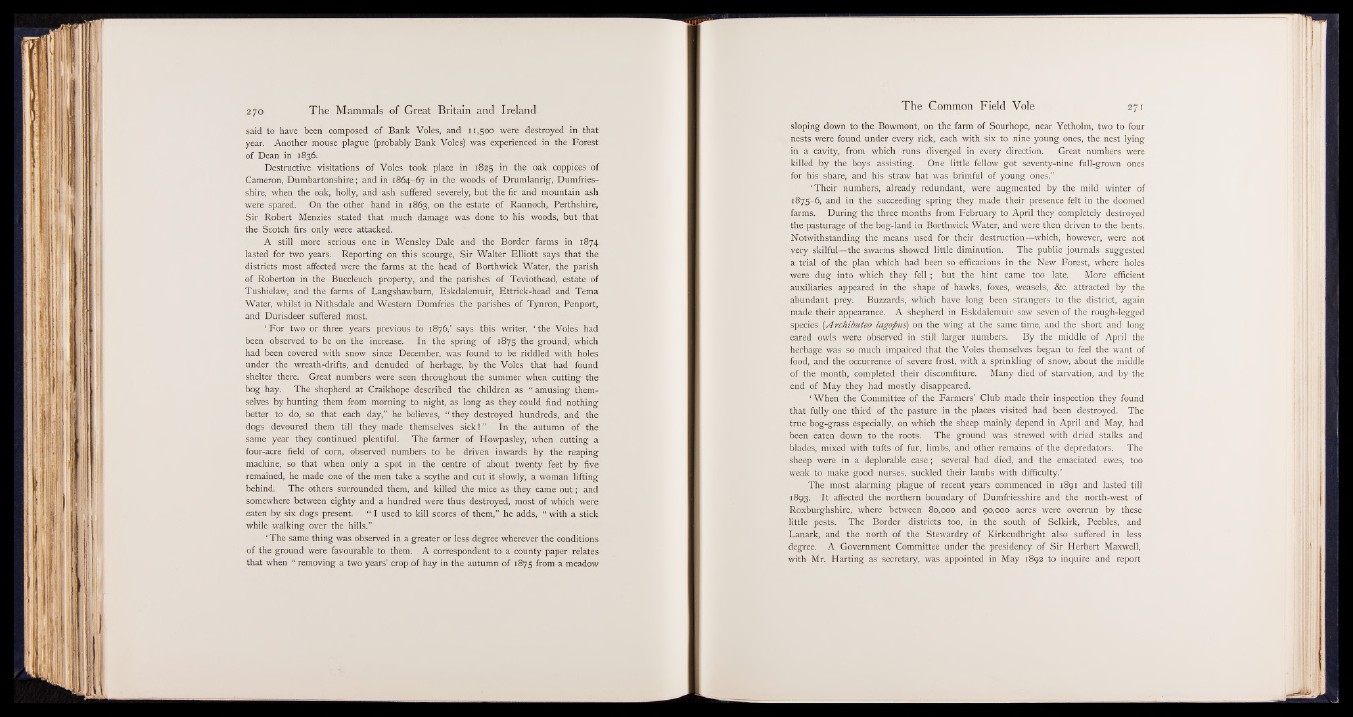
said to have been composed of Bank Voles, and 11,500 were destroyed in that
year. Another mouse plague (probably Bank Voles) was experienced in the Forest
of Dean in 1836.
Destructive visitations of Voles took place in 1825 in the oak coppices of
Cameron, Dumbartonshire; and in 1864-67 in the woods of Drumlanrig, Dumfriesshire,
when the oak, holly, and ash suffered severely, but the fir and mountain ash
were spared. On the other hand in 1863, on the estate of Rannoch, Perthshire,
Sir Robert Menzies stated that much damage was done to his woods, but that
the Scotch firs only were attacked.
A still more serious one in Wensley Dale and the Border farms in 1874
lasted for two years. Reporting on this scourge, Sir Walter Elliott says that the
districts most affected were the farms at the head of Borthwick Water, the parish
of Roberton in the Buccleuch property, and the parishes of Teviothead, estate of
Tushielaw, and the farms of Langshawburn, Eskdalemuir, Ettrick-head and Tema
Water, whilst in Nithsdale and Western Dumfries the parishes of Tynron, Penport,
and Durisdeer suffered most.
‘ For two or three years previous to 1876/ says this writer, ‘ the Voles had
been observed to be on the increase. In the spring of 1875 the ground, which
had been covered with snow since December, was found to be riddled with holes
under the wreath-drifts, and denuded of herbage, by the Voles that had found
shelter there. Great numbers were seen throughout the summer when cutting the
bog hay. The shepherd at Craikhope described the children as “ amusing themselves
by hunting them from morning to night, as long as they could find nothing
better to do, so that each day,” he believes, “ they destroyed hundreds, and the
dogs devoured them till they made themselves sick! ” In the autumn of the
same year they continued plentiful. The farmer of Howpasley, when cutting a
four-acre field of corn, observed numbers to be driven inwards by the reaping
machine, so that when only a spot in the centre of about twenty feet by five
remained, he made one of the men take a scythe and cut it slowly, a woman lifting
behind. The others surrounded them, and killed the mice as they came out; and
somewhere between eighty and a hundred were thus destroyed, most of which were
eaten by six dogs present. “ I used to kill scores of them,” he adds, “ with a stick
while walking over the hills.”
‘ The same thing was observed in a greater or less degree wherever the conditions
of the ground were favourable to them. A correspondent to a county paper relates
that when “ removing a two years’ crop of hay in the autumn of 1875 from a meadow
sloping down to the Bowmont, on the farm of Sourhope, near Yetholm, two to four
nests were found under every rick, each with six to nine young ones, the nest lying
in a cavity, from which runs diverged in every direction. Great numbers were
killed by the boys assisting. One little fellow got seventy-nine full-grown ones
for his share, and his straw hat was brimful of young ones.”
‘ Their numbers, already redundant, were augmented by the mild winter of
1875-6, and in the succeeding spring they made their presence felt in the doomed
farms. During the three months from February to April they completely destroyed
the pasturage of the bog-land in Borthwick Water, and were then driven to the bents.
Notwithstanding the means used for their destruction—which, however, were not
very skilful—the swarms showed little diminution. The public journals suggested
a trial of the plan which had been so efficacious in the New Forest, where holes
were dug into which they fell ; but the hint came too late. More efficient
auxiliaries appeared in the shape of hawks, foxes, weasels, &c. attracted by the
abundant prey. Buzzards, which have long been strangers to the district, again
made their appearance. A shepherd in Eskdalemuir saw seven of the rough-legged
species {Archibuteo lagopus) on the wing at the same time, and the short and long
eared owls were observed in still larger numbers. By the middle of April the
herbage was so much impaired that the Voles themselves began to feel the want of
food, and the occurrence of severe frost, with a sprinkling of snow, about the middle
of the month, completed their discomfiture. Many died of starvation, and by the
end of May they had mostly disappeared.
‘ When the Committee of the Farmers’ Club made their inspection they found
that fully one third of the pasture in the places visited had been destroyed. The
true bog-grass especially, on which the sheep mainly depend in April and May, had
been eaten down to the roots. The ground was strewed with dried stalks and
blades, mixed with tufts of fur, limbs, and other remains of the depredators. The
sheep were in a deplorable case; several had died, and the emaciated ewes, too
weak to make good nurses, suckled their lambs with difficulty.’
The most alarming plague of recent years commenced in 1891 and lasted till
1893. It affected the northern boundary of Dumfriesshire and the north-west of
Roxburghshire, where between 80,000 and 90,000 acres were overrun by these
little pests. The Border districts too, in the south of Selkirk, Peebles, and
Lanark, and the north of the Stewardry of Kirkcudbright also suffered in less
degree. A Government Committee under the presidency of Sir Herbert Maxwell,
with Mr. Harting as secretary, was appointed in May 1892 to inquire and report